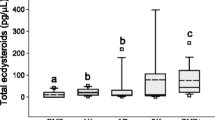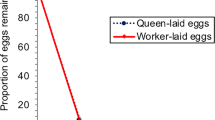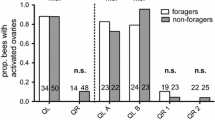Abstract
In this study, we investigated whether differences in the reproductive biology of honey bee (Apis mellifera) queens and laying workers are reflected in their eggs. We first tested the capacity of queen- and worker-laid male eggs to withstand dry conditions, by incubating samples at 30.0, 74.9, and 98.7% relative humidity. We found that worker-laid eggs were more sensitive to desiccation. Secondly, we measured the weight and quantities of vitellin, total protein, lipid, glycogen, and free carbohydrate in queen- and workerlaid eggs. Although worker-laid eggs were found to be heavier than queen-laid eggs in two of the four replicates, no systematic differences were found regarding nutrient content. Finally, we compared the duration of embryo development in the two egg types. Worker-laid eggs developed more slowly than queen-laid eggs in two out of three replicates, suggesting that they may only be partly mature at the moment they are laid. Possible causes and consequences of the observed differences are discussed.
Zusammenfassung
Königinnen und legende Arbeiterinnen der Honigbiene (Apis mellifera) unterscheiden sich in der Anatomie ihrer Geschlechtsorgane sowie in der Anzahl an Eiern, die sie produzieren können. Hier haben wir untersucht, ob sich die von beiden produzierten männlichen Eier ebenfalls unterscheiden. Zunächst verglichen wir die Schlupfraten von Königinnen-gelegten (Kg) und Arbeiterinnengelegten (Ag) Eiern aus drei Paaren von weiselrichtigen und weisellos Völkern bei unterschiedlichen Niveaus der relativen Luftfeuchte (Abb. 1, 2). Beide Eitypen zeigten sich empfindlich gegenüber Trockenheit, bei den Ag Eiern war dieser Effekt ausgeprägter als bei den Kg Eiern. Bei hoher Luftfeuchte unterschieden sich die Schlupfquoten der zwei Eitypen nicht voneinander.
In einem zweiten Experiment verglichen wir die Entwicklungsdauer von Ag und Kg Eiern. In zwei von drei Wiederholungen setzte der Eischlupf im Mittel bei den Kg Eiern früher ein (Abb. 3). Möglicherweise sind Ag Eier im Augenblick der Ablage in einem weniger fortgeschrittenen Ent wicklungs stadium.
Es ist bekannt, dass Ag Eier häufig größer und/oder schwerer sind als Kg Eier. Dies wurde damit erklärt, dass Arbeiterinnen eine geringere Anzahl an Eiern legen und daher mehr in jedes davon investieren könnten. Um das zu prüfen, haben wir die Mengen an Vitellin, Gesamtprotein, Glykogen, freiem Kohlenhydrat und Lipiden in Eiern aus vier Paaren von weiselrichtigen/weisellosen Völkern gemessen (Abb. 4). Ag Eier enthielten selten mehr Nährstoffe als Kg Eier, so dass die Hypothese widerlegt werden konnte.
Aus weiselrichtigen Völkern werden Ag Eier bekanntermaßen selektiv entfernt. Die höhere Empfindlichkeit gegenüber Dehydrierung könnte den beteiligten Arbeiterinnen dabei potentiell als Erkennungsmerkmal für Ag Eier dienen.
Similar content being viewed by others
References
Anderson R.H. (1963) The laying worker in the Cape honey bee, Apis mellifera capensis, J. Apicult. Res. 2, 85–92.
Beekman M., Oldroyd B.P. (2005) Honeybee workers use cues other than egg viability for policing, Biol. Lett. 1, 129–132.
Büdel A. (1948) Der Wasserdampfhaushalt im Bienenstock, Z. Vergl. Physiol. 31, 249–273.
Büdel A. (1960) Bienenphysik, in: Büdel A., Herold E. (Eds.), Biene und Bienenzucht, Ehrenwirth, Munich, pp. 115–180.
Buttel-Reepen H. v. (1915) Leben und Wesen der Biene, F. Vieweg und Sohn, Braunschweig.
Dade H.A. (1962) Anatomy and dissection of the honeybee, International Bee Research Association, London.
Engels W. (1972) Quantitative Untersuchungen zum Dotterprotein-Haushalt der Honigbiene (Apis mellifica), Wilhelm Roux’ Archiv 171, 55–86.
Gençer H.V., Woyke J. (2006) Eggs from Apis mellifera caucasica laying workers are larger than from queens, J. Apicult. Res. 45, 173–179.
Gillooly J.F., Dodson S.I. (2000) The relationship of egg size and incubation temperature to embryonic development time in univoltine and multivoltine aquatic insects, Freshw. Biol. 44, 595–604.
Gillooly J.F., Charnov E.L., West G.B., Savage V.M., Brown J.H. (2002) Effect of size and temperature on developmental time, Nature (Lond.) 417, 70–73.
Gontarski H. (1938) Beobachtungen an eierlegenden Arbeiterinnen, Deutscher Imkerführer 12, 107–113.
Harbo J.R., Bolten A.B. (1981) Development times of male and female eggs of the honey bee, Ann. Entomol. Soc. Am. 74, 504–506.
Hemmling C. (1991) Production and sexual maturity of drones in queenless colonies, Apidologie 22, 435–436.
Kapil R.P. (1962) Anatomy and histology of the female reproductive system of Apis indica F. (Hymenoptera. Apidae), Insectes Soc. 9, 145–163.
Katzav-Gozansky T., Soroker V., Hefetz A. (2002) Honeybees Dufour’s gland — idiosyncrasy of a new queen signal, Apidologie 33, 525–537. Katzav-Gozansky T., Soroker V., Hefetz A.,
Cojocaru M., Erdmann D.H., Francke W. (1997) Plasticity of caste-specific Dufour’s gland secretion in the honey bee (Apis mellifera L.), Naturwissenschaften 84, 238–241.
Katzav-Gozansky T., Soroker V., Ibarra F., Francke W., Hefetz A. (2001) Dufour’s gland secretion of the queen honeybee (Apis mellifera): an egg discriminator pheromone or a queen signal? Behav. Ecol. Sociobiol. 51, 76–86.
Katzav-Gozansky T., Soroker V., Kamer J., Schulz C.M., Francke W., Hefetz A. (2003) Ultrastrucutral and chemical characterization of egg surface of honeybee worker and queen-laid eggs, Chemoecology 13, 129–134.
Leoni G.G., Succu S., Berlinguer F., Rosati I., Bebbere D., Bogliolo L., Ledda S., Naitana S. (2006) Delay on the in vitro kinetic development of prepubertal ovine embryos, Anim. Reprod. Sci. 92, 373–383.
Lindauer M. (1954) Temperaturregulierung und Wasserhaushalt im Bienenstaat, Z. Vergl. Physiol. 36, 391–432.
Lorenz M.W. (2003) Adipokinetic hormone inhibits the formation of energy stores and egg production in the cricket Gryllus bimaculatus, Comp. Biochem. Physiol. B 136, 197–206.
Lorenz M.W. (2007) Oogenesis-flight syndrome in crickets: age-dependent egg production, flight performance, and biochemical composition of the flight muscles in adult female Gryllus bimaculatus, J. Insect Physiol. 53, 819–832.
Mackasmiel L.A.M., Fell R.D. (2000) Respiration rates in eggs of the honey bee, Apis mellifera, J. Apicult. Res. 39, 125–135.
Martin S.J., Châline N., Oldroyd B.P., Jones G.R., Ratnieks F.L.W. (2004) Egg marking pheromones of anarchistic worker honeybees, Behav. Ecol. 15, 839–844.
Martin S.J., Châline N., Ratnieks F.L.W., Jones G.R. (2005) Searching for the egg-marking signal in honeybees, J. Negative Results 2, 1–9.
Martin S.J., Jones G.R., Châline N., Middleton H., Ratnieks F.L.W. (2002) Reassessing the role of the honeybee (Apis mellifera) Dufour’s gland in egg marking, Naturwissenschaften 89, 528–532.
Nonacs P. (2006) Nepotism and brood reliability in the suppression of worker reproduction in the eusocial Hymenoptera, Biol. Lett. 2, 577–579.
Page R.E., Erickson E.H. (1988) Reproduction by worker honey bees (Apis mellifera L.), Behav. Ecol. Sociobiol. 23, 117–126.
Pirk C.W.W., Neumann P., Hepburn R., Moritz R.F.A., Tautz J. (2004) Egg viability and worker policing in honey bees, Proc. Natl Acad. Sci. (USA) 101, 8649–8651.
Pirk C.W.W., Neumann P., Ratnieks F.L.W. (2003) Cape honeybees, Apis mellifera capensis, police worker-laid eggs despite the absence of relatedness benefits, Behav. Ecol. 14, 347–352.
Ratnieks F.L.W. (1992) Evidence for an egg-marking pheromone in the honey bee, Am. Bee J. 132, 813.
Ratnieks F.L.W. (1995) Evidence for a queen-produced egg-marking pheromone and its use in worker policing in the honey-bee, J. Apicult. Res. 34, 31–37.
Ratnieks F.L.W., Visscher P.K. (1989) Worker policing in the honeybee, Nature (Lond.) 342, 796–797.
Reginato R.D., Cruz-Landim C. (2003) Ovarian growth during larval development of queen and worker of Apis mellifera (Hymenoptera: Apidae): A morphometric and histological study, Braz. J. Biol. 63, 121–127.
Reinhardt E. (1960) Kernverhältnisse, Eisystem und Entwicklungsweise von Drohnen- und Arbeiterinneneiern der Honigbiene (Apis mellifera), Zool. Jahrbuch (Anatomie) 78, 167–231.
Rhein W. v. (1933) Über die Entstehung des weiblichen Dimorphismus im Bienenstaate, Roux’s Arch. Dev. Biol. 129, 601–665.
Ribbands C.R. (1953) The behaviour and social life of honeybees, Bee Research Association, London.
Rizos D., Bermejo-Alvarez P., Gutierrez-Adan A., Lonergan P. (2008) Effect of duration of oocyte maturation on the kinetics of cleavage, embryo yield and sex ratio in cattle, Reprod. Fert. Develop. 20, 734–740.
Schäfer M.O., Dietemann V., Pirk C.W.W., Neumann P., Crewe R.M., Hepburn H.R., Tautz J., Crailsheim K. (2006) Individual versus social pathway to honeybee worker reproduction (Apis mellifera): pollen or jelly as protein source for oogenesis? J. Comp. Physiol. A-Sens. Neural Behav. Physiol. 192, 761–768.
Schuetz A. (1975) Cytoplasmic activation of starfish oocytes by sperm and divalent ionophore A-23187, J. Cell Biol. 66, 86–94.
Snodgrass R.E. (1956) Anatomy of the honey bee, Comstock Publishers Associates, Ithaca, New York.
Taber S. (1961) Forceps design for transferring honey bee eggs, J. Econ. Entomol. 54, 247–250.
Tanaka E., Hartfelder K. (2004) The initial stages of oogenesis and their relation to differetial fertility in the honey bee (Apis mellifera) castes, Arthropod Struct. Dev. 33, 431–442.
Trougakos I.P., Margaritis L.H. (2002) Novel morphological and physiological aspects of insect eggs, in: Hilkers M., Meiners T. (Eds.), Chemoecology of insect eggs and egg deposition, Blackwell, Oxford, pp. 3–36.
Velthuis H.H.W., Alves D.D.A., Imperatriz-Fonseca V., Duchateau M.J. (2002) Worker bees and the fate of their eggs, Proc. Sect. Exp. Appl. Entomol. Neth. Entomol. Soc. 13, 97–102.
Visscher P.K. (1989) A quantitative study of worker reproduction in honey bee colonies, Behav. Ecol. Sociobiol. 25, 247–254.
Visscher P.K. (1996) Reproductive conflict in honey bees: A stalemate of worker egg-laying and policing, Behav. Ecol. Sociobiol. 39, 237–244.
Wegener J., Bienefeld K. (2009) Methoden zur Zucht der Honigbiene unter Nutzung der Nachkommen von Arbeiterinnen, Züchtungskunde 81, 265–278.
Wegener J., Lorenz M.W., Bienefeld K. (2009) Physiological consequences of prolonged nursing in the honey bee, Insect. Soc. 56, 85–93.
Winston M.L. (1987) The biology of the honey bee, Harvard University Press, Cambridge and London.
Wohlgemuth R. (1957) Die Temperaturregulation des Bienenvolkes unter regeltheoretischen Gesichtspunkten, Z. Vergl. Physiol. 40, 119–161.
Woyciechowski M., Lomnicki A. (1987) Multiple mating of queens and the sterility of workers among eusocial Hymenoptera, J. Theor. Biol. 128, 317–327.
Woyke J. (1994) Comparison of the size of eggs from Apis mellifera L. queens and laying workers, Apidologie 25, 179–187.
Zander E. (1916) Die Ausbildung des Geschlechtes bei der Honigbiene (Apis mellifica L.), Z. Angew. Entomol. 3, 1–74.
Zander E. (1951) Der Bau der Biene, Eugen Ulmer, Stuttgart.
Author information
Authors and Affiliations
Corresponding author
Additional information
Manuscript editor: Stefan Fuchs
Rights and permissions
About this article
Cite this article
Wegener, J., Lorenz, M.W. & Bienefeld, K. Differences between queen- and worker-laid male eggs of the honey bee (Apis mellifera). Apidologie 41, 116–126 (2010). https://doi.org/10.1051/apido/2009061
Received:
Revised:
Accepted:
Issue Date:
DOI: https://doi.org/10.1051/apido/2009061




